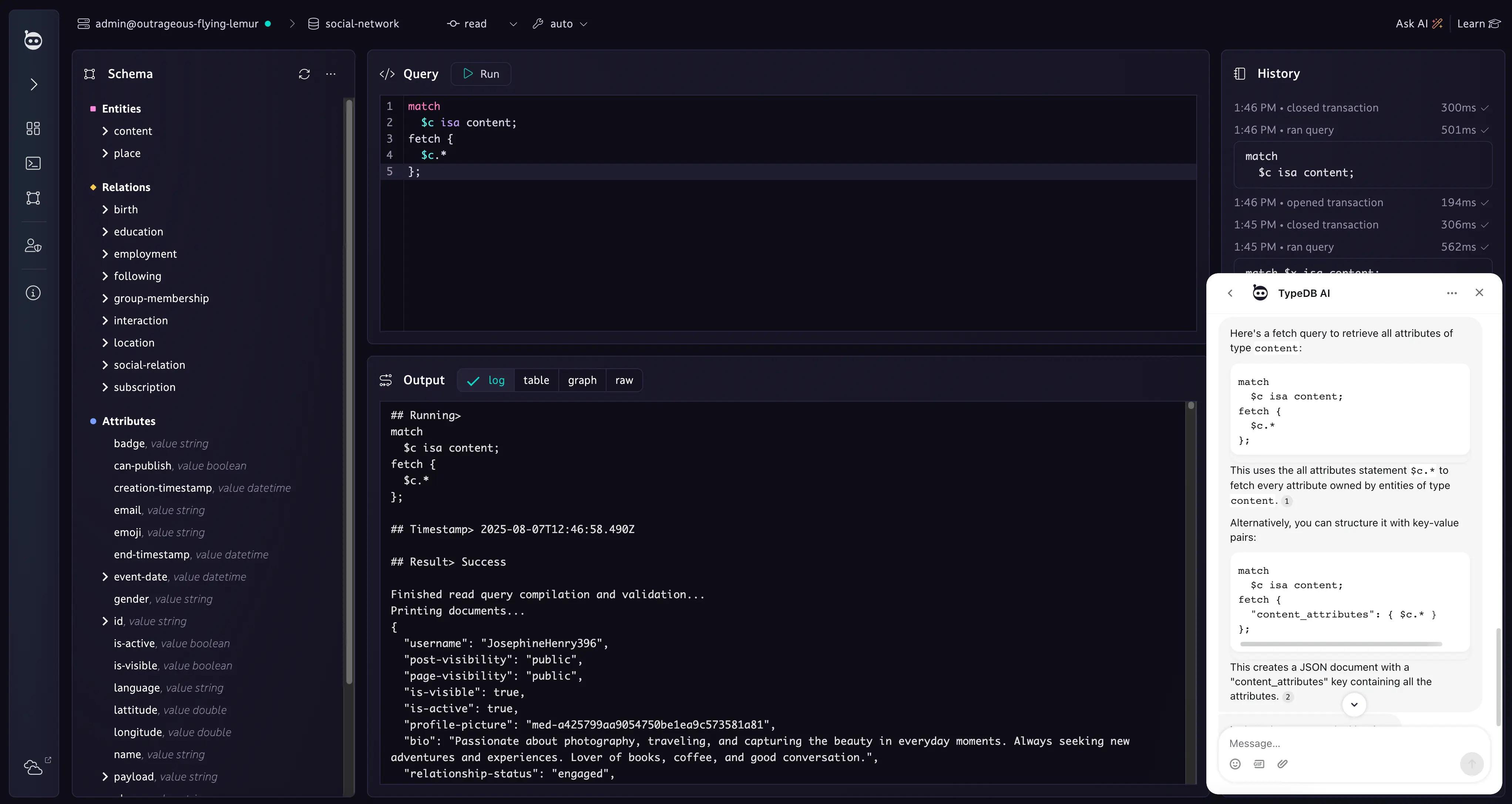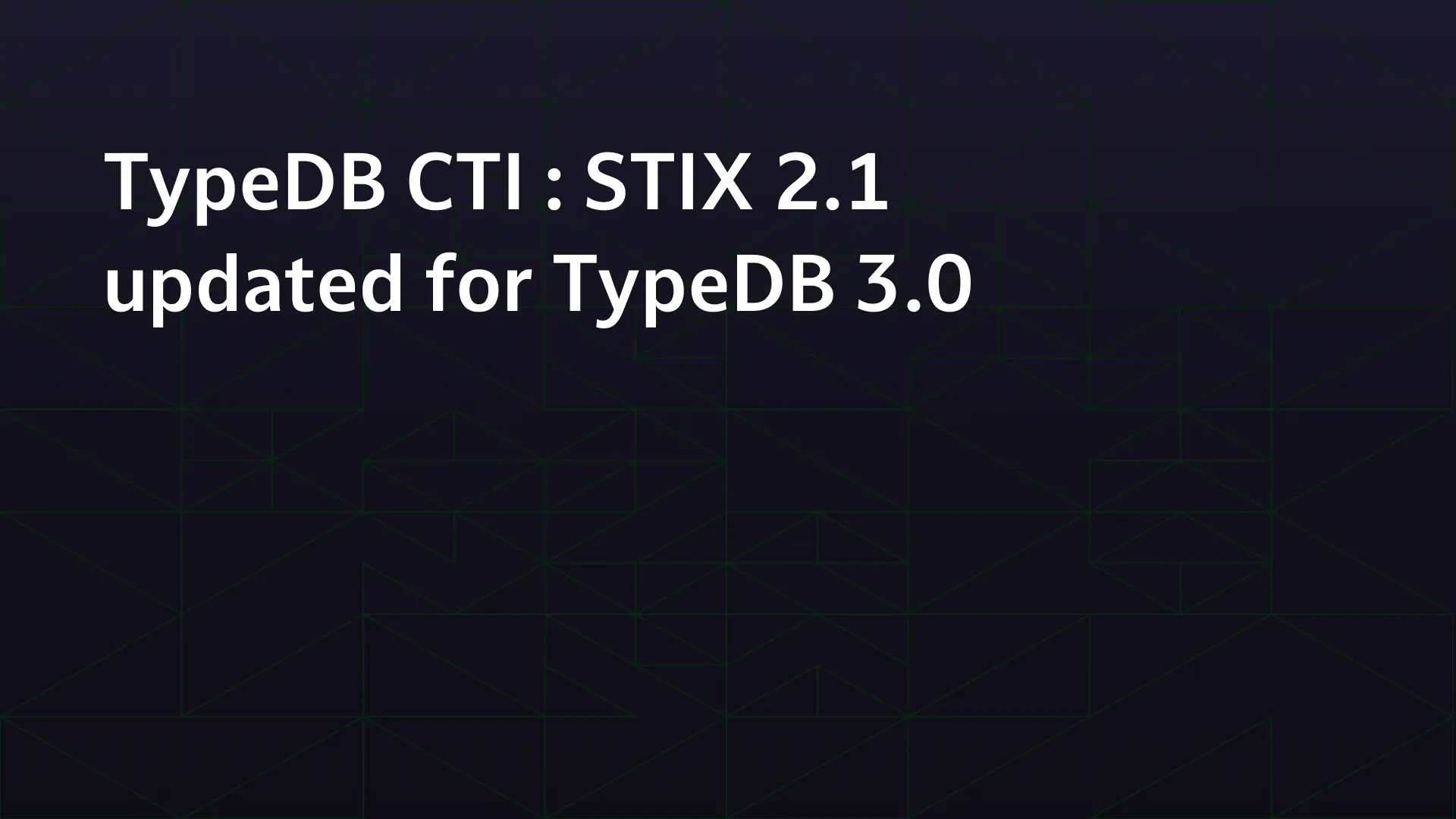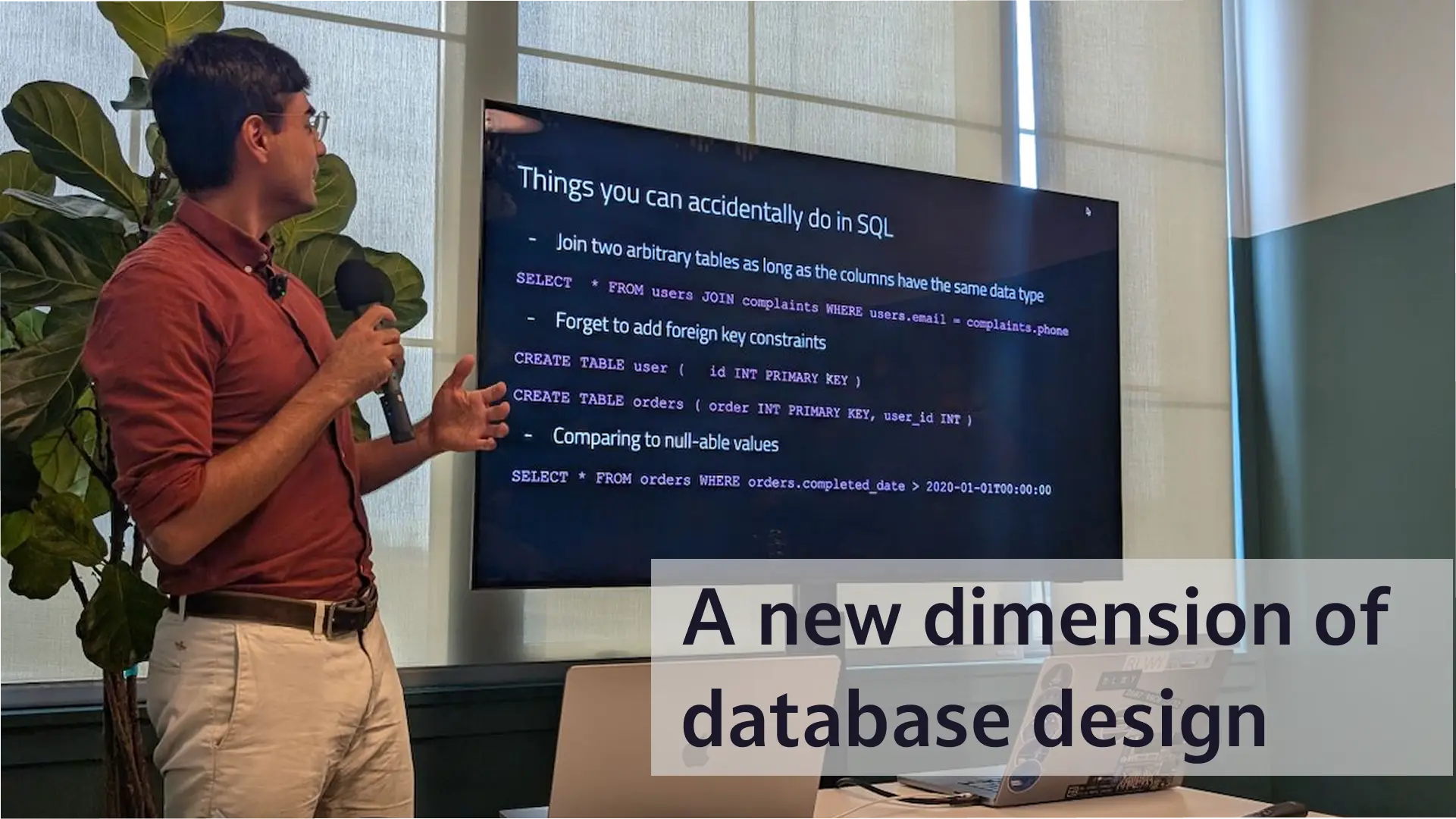Built for systems, not records
Tables and edges capture your data, but they force system logic into code. TypeDB is a systems database. It enforces that logic at the data layer, so your application doesn't have to reinvent it everywhere.
- 1
- 2
- 3
- 4
- 5
- 6
- 7
- 8
insert
$sql isa language;
$typeql isa language;
(past: $sql, future: $typeql) isa evolution;
Learn about the hot topics at TypeDB
Structured for machines, intuitive for humans
TypeQL is human readable, machine writable language built on modern programming paradigms, that allows you to embed logic into the database.
Its clarity and structured nature make it perfect for LLMs and vibe coding, readying your data for the next wave of AI-driven applications and automation.
- 1
- 2
- 3
- 4
- 5
- 6
- 7
- 8
- 9
- 10
- 11
- 12
- 13
- 14
- 15
- 16
- 17
- 18
- 19
- 20
- 21
- 22
- 23
- 24
- 25
define
attribute username, value string;
attribute page-visibility, value string @values("public", "private");
attribute address, value string;
attribute dob, value date;
entity profile @abstract,
owns username @key,
owns page-visibility @card(1);
entity person,
sub profile,
owns dob,
plays employment:employee;
entity company,
sub profile,
owns address @card(0..),
plays employment:employer;
relation employment,
relates employer,
relates employee;A database for complex systems
Forget tables and joins. TypeDB is built to model multi-dimensional, highly interconnected data, without losing structure or semantic meaning.

A programming language, not just a schema
With TypeQL, you describe your data like code. It’s readable, writable, and logical, enabling full expressiveness with real constraints and inference.
TypeDB
Find users that have access to different types of resources. Return user emails, resource IDs and resource types
- 1
- 2
- 3
- 4
- 5
- 6
- 7
- 8
- 9
- 10
- 11
match
$user isa user;
$resource isa! $resource-type;
$resource-type sub resource;
resource-ownership (resource: $resource, owner: $user);
fetch {
"email": $user.email,
"resource-id": $resource.id,
"resource-type": $resource-type
};Relational
In relational DBs, define one table for each resource type, using a UNION ALL query and JOINs to fetch interconnected data
- 1
- 2
- 3
- 4
- 5
- 6
- 7
- 8
- 9
- 10
- 11
- 12
- 13
- 14
- 15
- 16
- 17
- 18
- 19
- 20
- 21
- 22
- 23
- 24
- 25
- 26
- 27
- 28
- 29
- 30
- 31
- 32
- 33
- 34
- 35
- 36
- 37
- 38
- 39
- 40
- 41
- 42
- 43
- 44
- 45
- 46
- 47
- 48
- 49
- 50
- 51
- 52
- 53
- 54
- 55
- 56
- 57
- 58
- 59
- 60
- 61
- 62
- 63
- 64
- 65
- 66
- 67
- 68
- 69
- 70
- 71
- 72
- 73
- 74
- 75
- 76
- 77
- 78
- 79
- 80
- 81
- 82
- 83
- 84
- 85
- 86
SELECT
ue.email AS email,
'file' AS resource_type,
f.path AS id
FROM users u
JOIN user_emails ue
ON u.id = ue.user_id
JOIN resource_ownerships ro
ON u.id = ro.user_id
JOIN resources r
ON ro.resource_id = r.id
JOIN files f
ON r.id = f.resource_id
UNION ALL
SELECT
ue.email AS email,
'directory' AS resource_type,
d.path AS id
FROM users u
JOIN user_emails ue
ON u.id = ue.user_id
JOIN resource_ownerships ro
ON u.id = ro.user_id
JOIN resources r
ON ro.resource_id = r.id
JOIN directories d
ON r.id = d.resource_id
UNION ALL
SELECT
ue.email AS email,
'commit' AS resource_type,
c.hash AS id
FROM users u
JOIN user_emails ue
ON u.id = ue.user_id
JOIN resource_ownerships ro
ON u.id = ro.user_id
JOIN resources r
ON ro.resource_id = r.id
JOIN commits c
ON r.id = c.resource_id
UNION ALL
SELECT
ue.email AS email,
'repository' AS resource_type,
re.name AS id
FROM users u
JOIN user_emails ue
ON u.id = ue.user_id
JOIN resource_ownerships ro
ON u.id = ro.user_id
JOIN resources r
ON ro.resource_id = r.id
JOIN repositories re
ON r.id = re.resource_id
UNION ALL
SELECT
ue.email AS email,
'table' AS resource_type,
t.name AS id
FROM users u
JOIN user_emails ue
ON u.id = ue.user_id
JOIN resource_ownerships ro
ON u.id = ro.user_id
JOIN resources r
ON ro.resource_id = r.id
JOIN tables t
ON r.id = t.resource_id
UNION ALL
SELECT
ue.email AS email,
'database' AS resource_type,
f.name AS id
FROM users u
JOIN user_emails ue
ON u.id = ue.user_id
JOIN resource_ownerships ro
ON u.id = ro.user_id
JOIN resources r
ON ro.resource_id = r.id
JOIN databases d
ON r.id = d.resource_id;
Document
In document DBs, freeform structures make writes trivial, but reading and validating data becomes a significant challenge
- 1
- 2
- 3
- 4
- 5
- 6
- 7
- 8
- 9
- 10
- 11
- 12
- 13
- 14
- 15
- 16
- 17
- 18
- 19
- 20
- 21
- 22
- 23
- 24
- 25
- 26
- 27
- 28
- 29
- 30
- 31
- 32
- 33
- 34
- 35
- 36
- 37
- 38
- 39
- 40
- 41
- 42
- 43
- 44
- 45
- 46
- 47
- 48
- 49
- 50
- 51
- 52
- 53
- 54
- 55
- 56
- 57
- 58
- 59
- 60
- 61
- 62
- 63
- 64
- 65
- 66
- 67
- 68
- 69
- 70
- 71
- 72
- 73
- 74
- 75
- 76
- 77
- 78
- 79
- 80
- 81
- 82
- 83
- 84
- 85
- 86
- 87
- 88
- 89
- 90
- 91
- 92
- 93
- 94
- 95
db.resource_ownerships.aggregate( [
{
$lookup:
{
from: "resources",
localField: "resource",
foreignField: "_id",
as: "resource"
}
},
{
$unwind:
{
path: "$resource"
}
},
{
$lookup:
{
from: "users",
localField: "owner",
foreignField: "_id",
as: "owner"
}
},
{
$unwind:
{
path: "$owner"
}
},
{
$unwind:
{
path: "$owner.emails"
}
},
{
$addFields:
{
resource_id: {
$switch: {
branches: [
{
case: {
$eq: ["$resource.resource_type", "file"]
},
then: "$resource.path"
},
{
case: {
$eq: ["$resource.resource_type", "directory"]
},
then: "$resource.path"
},
{
case: {
$eq: ["$resource.resource_type", "commit"]
},
then: "$resource.hash"
},
{
case: {
$eq: ["$resource.resource_type", "repository"]
},
then: "$resource.name"
},
{
case: {
$eq: ["$resource.resource_type", "table"]
},
then: "$resource.name"
},
{
case: {
$eq: ["$resource.resource_type", "database"]
},
then: "$resource.name"
}
]
}
}
}
},
{
$project: {
_id: false,
email: "$owner.emails",
resource_type: "$resource.resource_type",
id: "$resource_id"
}
}
] )
Graph
In graph DBs, properties are attached directly to the nodes that own them, rather than being nodes themselves
- 1
- 2
- 3
- 4
- 5
- 6
- 7
- 8
- 9
- 10
- 11
- 12
- 13
- 14
- 15
- 16
- 17
- 18
- 19
- 20
- 21
- 22
- 23
- 24
- 25
MATCH
(user:User)-[:OWNS]->(rsrc:Resource)
WITH
rsrc,
[user.primary_email] + user.alias_emails AS emails,
labels(rsrc) AS resource_types,
keys(rsrc) AS properties
UNWIND emails AS email
UNWIND resource_types AS resource_type
WITH
rsrc, email, resource_type, properties,
{
File: "path",
Directory: "path",
Commit: "hash",
Repository: "name",
Table: "name",
Database: "name"
} AS id_type_map
WHERE resource_type IN keys(id_type_map)
AND id_type_map[resource_type] IN properties
RETURN email, resource_type, rsrc[id_type_map[resource_type]] AS id
The power of a knowledge graph
TypeDB uses a hypergraph model to represent entities, relationships, and nested concepts natively, making it uniquely suited for applications where context, structure, and inference matter.

Explore with our live web studio
Want to dive in and see what TypeDB can do? Sign up to Cloud and connect instantly to our web studio to see what we can do in just a few minutes.

Collaborate with other builders
We are used by major enterprises, cutting edge AI businesses, world-leading researchers, and everything else you can imagine.
GitHub
Discord
YouTube
Leverage the power of programming.
In your database
Using the Polymorphic-Entity-Relations-Attribute (PERA) model as the basis of TypeQL leads to a general, expressive, intuitive, and strongly typed language! Since data must be instantiated from the schema, the system can make strong guarantees about data integrity and shape.
Write less to do more
Queries are shorter, more intuitive, and more expressive. You don’t have to specify how data joins; Just say what you need and retrieve it in a simple, single database call.
Eliminate a significant amount of your tech debt
Data logic belongs in the structure, not the query. Our query variables match all valid types so doesn’t need updating even when you add new subtypes.
Your data holds more answers than you know
TypeDB is the only database built for interconnected data and intelligent applications. Build systems that understand, reason, and adapt, solving problems traditional databases cannot.

Batteries included
Connect your production application with our dedicated drivers, supporting the major languages, with more added regularly.
Useful resources to get started
Start free, upgrade when ready
Go to production in weeks, not months
TypeDB delivers a clear, structured data model and a human-readable, beautiful query language, ideal for powering agentic systems, cyber threat intelligence, robotics and much more.












